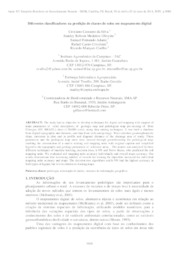Diferentes classificadores na predição de classes de solos em mapeamento digital.
Diferentes classificadores na predição de classes de solos em mapeamento digital.
Author(s): SILVA, C. C. da; OLIVEIRA, S. R. de M.; ADAMI, S. F.; CRIVELENTI, R. C.; COELHO, R. M.
Summary: ABSTRACT: The study had as objective to develop techniques for digital soil mapping with support of main parameters of relief descriptors, of geologic map and pedological map pre-existing of Dois Córregos (SP, BRAZIL) sheet (1:50,000 scale), using data mining techniques. It was built a database from digital topographic and thematic, and data from soils and geology. Were calculate geomorphometric slope, curvature in plan and in profile and diagonal distance of the drainage area of study. These parameters and the geological map units were crossed through georeferencing the pedological map, enabling the construction of a matrix relating soil mapping units with original caption and simplified legend to the topography and geology parameters of reference areas.. This matrix was analyzed by three different techniques of machine learning, decision trees, k-NN and Naive Bayes, who predicted the soil mapping units. We evaluated soil mapping units accuracy individually and overall maps accuracy. Our results demonstrate that increasing number of records for training the algorithm increased the individual mapping units accuracy and maps. The decision tree algorithms and k-NN had the highest accuracy in both types of legend, but low in relation to training maps.
Publication year: 2011
Types of publication: Paper in annals and proceedings
Observation
Some of Embrapa's publications are published as ePub files. To read them, use or download one of the following free software options to your computer or mobile device. Android: Google Play Books; IOS: iBooks; Windows and Linux: Calibre.
Access other publications
Access the Agricultural Research Database (BDPA) to consult Embrapa's full library collection and records.
Visit Embrapa Bookstore to purchase books and other publications sold by Embrapa.

